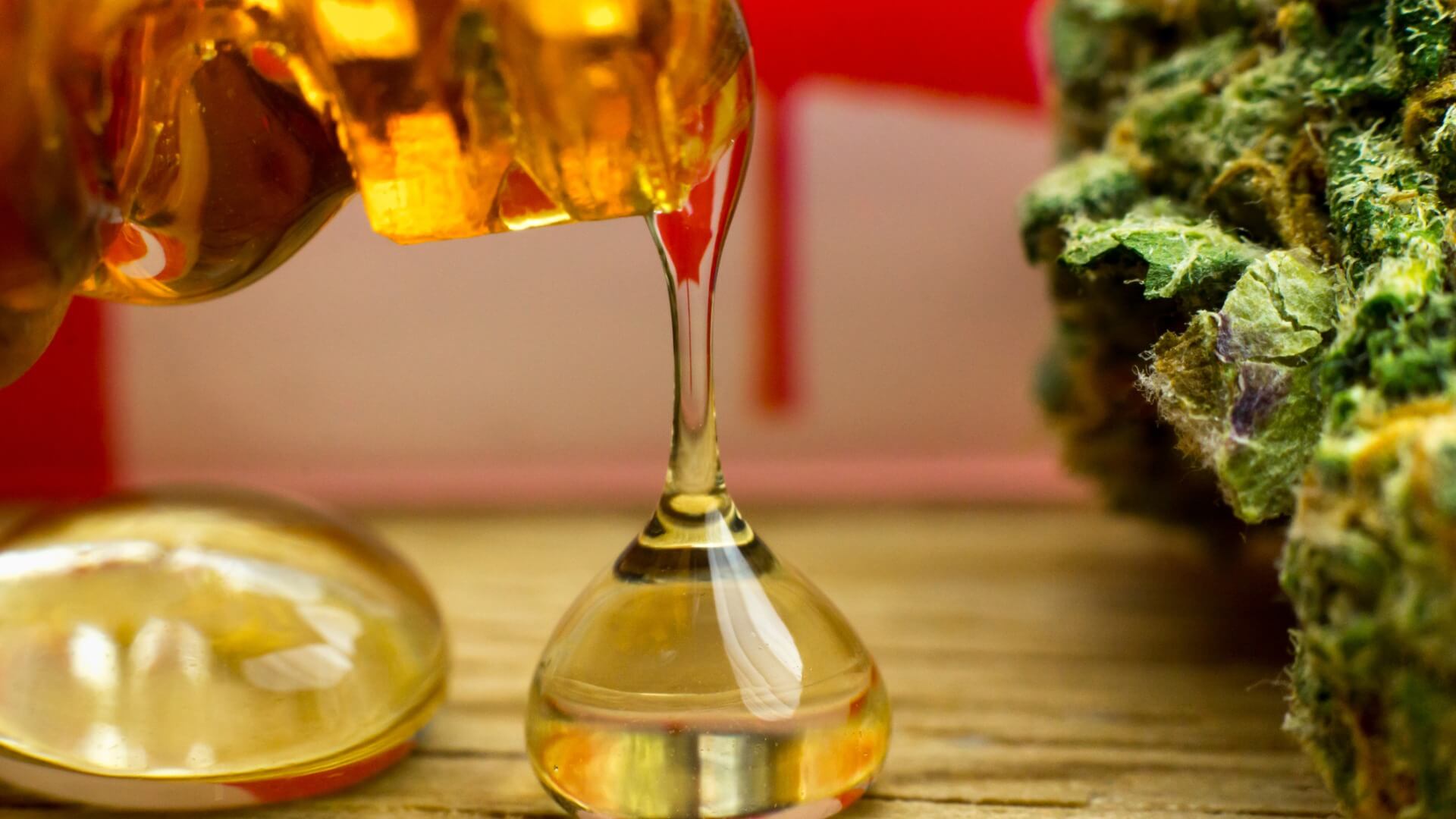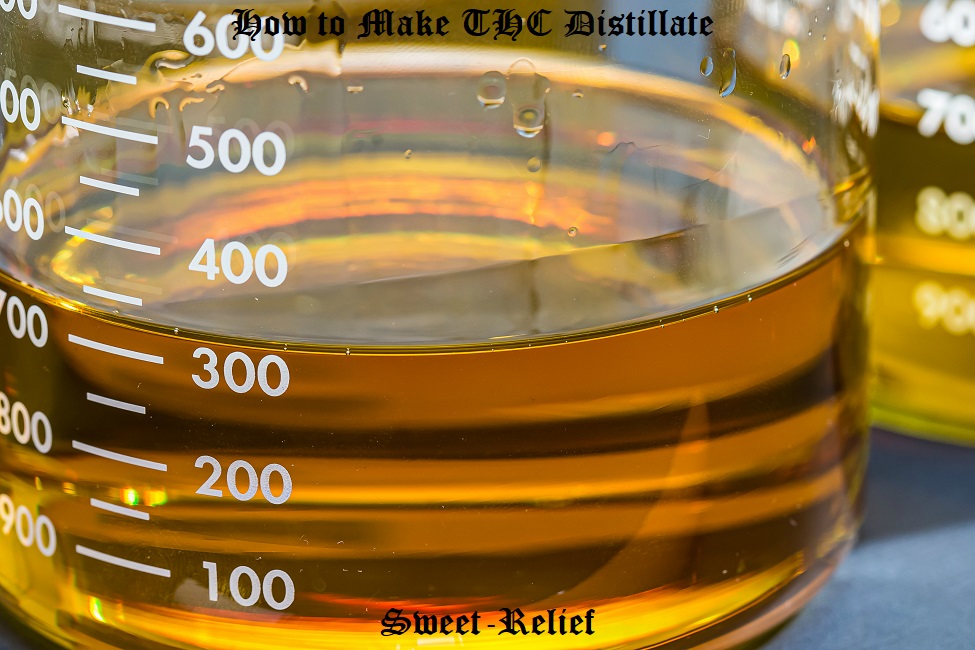Cannabis distillates are a new type of cannabis concentrate making waves in the marijuana industry. These distillates can either be in the form of THC distillate or CBD distillate and are created through a process known as distillation. Though they are quickly becoming very popular, consumers should be careful when using them because they are refined and almost 100% pure.
What is Cannabis Distillate?

Cannabis distillate is a type of marijuana extract which, as the name suggests, has undergone distillation. One method for doing this is Short Path Distillation. This method strips cannabis of everything except for the core compound, known as the cannabis distillate. Distillates do not have any flavor, taste, or aroma.
Here is where things get tricky. All cannabis distillates are oils; however, not all cannabis oils are distillates. Cannabis oil is only a distillate if it has been stripped of all other materials except for one.
Although distillates lack terpenes and other naturally occurring flavors and aromas, they are still very potent.
How to Make Cannabis Distillate
Before you can make a cannabis distillate, marijuana extracts have to undergo winterization and decarboxylation. Then, you can finally begin distillation.
The cannabis distillate process starts with extraction. This is where you separate cannabinoids from the marijuana plant(Blueberry Cheesecake or youe favorite strain).
Cannabis Extraction
Extraction is when you use solvents, such as ethanol, carbon dioxide, or a hydrocarbon, to extract raw marijuana oil, also referred to as crude oil. The level of THC/CBD in crude oil ranges between 60% to 80%. You can also extract marijuana physically through sieving or using a rosin press. Compared to solvent extraction, the physical method produces more impure cannabis extracts.
Winterization
The cannabis extract is passed through a purification process through which the unwanted byproducts such as plant waxes, lipids, fats, chlorophyll, and contaminants are removed. This takes place in a freezing environment.
The raw marijuana oil is mixed with ethanol. The mixed solution is then placed in a freezing environment for up to 48 hours. During this time, the impurities coagulate and separate, remaining at the bottom of the mixture. The mixture is then filtered, with the impurities left behind, giving you a purer concentration of the extract. A rotary evaporator or a falling film evaporator is used to remove ethanol from the mixture, leaving you with a solvent-free extract.
Decarboxylation
Decarboxylation removes the carboxylic acid from the chemical compound by applying heat. When the THCA is taken through decarboxylation, the carboxylic acid (A) is removed, resulting in THC.
Time and temperature play a huge role in THCA decarboxylation. Transformation begins when temperatures reach 220 degrees Fahrenheit. Decarboxylation allows THC to interact with the nervous system and the cannabinoid receptors, CB1 and CB2, thus enabling you to benefit from both the medicinal and psychoactive effects of THC.
It is important to note that THCA is not the only cannabinoid that needs to be decarboxylated for it to have the desired impact on the human body. All cannabinoids in their acidic forms must be decarboxylated. These cannabinoids include:
- CBGA (cannabigerol acid) -CBG (cannabigerol)
- THCVA (tetrahydrocannabivarin acid) – THCV (tetrahydrocannabivarin)
- CBDA (cannabidiolic acid) – CBD (cannabidiol)
- CBCA (cannabichromenenic acid) – CBC (cannabichromene)
- CBGVA (cannabigerovarinic acid) -CBGV (cannabigerivarin)
- CBDVA (cannabidivarinic acid) -CBDV (cannabidivarin)
- CBCVA (cannabichromevarinic acid) -CBCV (cannabichromevarin)
Distillation

For an effective and efficient distillation of cannabis extract, you’ll need a cannabis distillation kit.
Distillation is the final process for making cannabis oil. It is a purification process that uses heat, steam, and vacuum pressure to separate all the chemical compounds in the concentrate and produce a concentrated cannabinoid distillate. During distillation, terpenes and flavonoids are removed from the mixture for a pure cannabinoid.
The process of extracting terpenes and flavonoids requires careful monitoring according to their unique boiling points. The presence of a vacuum during distillation helps with temperature control, thus, reducing the need for high heat, which could eventually reduce your potency. The process separates the chemical compounds while also discarding unwanted materials. This leaves behind a refined and almost 100% cannabinoid, also known as cannabis distillate.
Since the cannabis distillate alone doesn’t trigger the entourage effects, you’ll need to take extra steps to preserve the various compounds (cannabinoids, terpenes, and flavonoids). You can use steam distillation and fractionation and, at the same time, remove all the solvent.
A cannabis distillation kit contains the following equipment:
- Heating items
- Cooling units
- Vacuum pump system
- Spare containers for product collection,
- Spare parts
Below is the process of preserving the various compounds to produce a final cannabis distillate that is 99% pure, potent, and effective.
- Extract all the cannabinoids, terpenes, and flavonoids using a solvent.
- Use heat (below 315 degrees Fahrenheit) to boil off the terpenes and flavonoids.
- Allow the steam to pass through a tube, which is cooled with distilled water for cannabis. This will condense the vapor into a liquid. You’ve now collected the terpenes and flavonoids.
- Raise the temperature to boil off the cannabinoids.
- Continue heating and adjust the temperature, allow the steam distilled cannabis oil to pass through a pipe that is cooled by distilled water for cannabis, thereby condensing the vapor into liquid. Now you’ve gathered the cannabinoid in a separate fluid.
- Mix the two liquids (steam distilled cannabis oil, terpenes, and flavonoids) and voila! You now have a cannabis/THC distillate that is almost 100% pure, highly potent, and extremely effective!
How is THC Distillate Made?
Want to know how to make THC distillate? Distilling THC requires expensive and advanced equipment and is best performed in a controlled, professional laboratory setting.
Due to the high startup cost and difficulty involved, it is generally a more safe and economical choice to leave this one to the professionals.
The process involves several levels of extraction and purification to yield a product that is highly-refined, pure, and potent.
What is THC distillate used for?
THC distillate is as versatile as it is potent, and it can be consumed in a variety of ways.
- Dabs – THC distillate is a highly-refined cannabis concentrate and can be used in the same way as other concentrates like wax, shatter, or bubble hash. Simply heat up your dab rig and dab as usual, keeping in mind that THC distillate can be over 99% pure THC. Start with only a very small amount.
- Vaping – THC distillate can be vaped from a vape pen or other vaporizer product. When purchased from a reputable source and extracted with supercritical CO2, vaping with THC distillate can be a cleaner option compared to butane hash oil.
There are also a number of dab-free and vape-free ways to consume THC distillate. Distillate has already been decarboxylated during the refinement process, meaning it does not require heat to become active.
Some may choose to make their distillate into a tincture and take it sublingually, allowing the cannabinoids to absorb under the tongue.
Decarboxylation also means that THC distillate is ready to use for all kinds of edibles from green smoothies to a chocolatey space cake.
We recommend you leave THC distillate-making to the professionals, but we hope you enjoyed learning more about the process. Consider picking up some THC distillate on your next trip to the dispensary.
